Canada's house prices continue to slow, demand remains strong
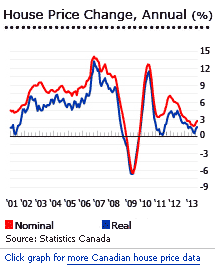
The Canadian house price rises continue to subside, amidst the government’s continuous implementation of several rounds of housing market cooling measures.
House prices in the country´s eleven major cities rose by just 2.68% during the year to end-Q3 2013, from year-on-year price rises of 1.81% in Q2 2013, 2.6% in Q1 2013, and 3.08% in Q4 2012, based on figures released by the Teranet – National Bank of Canada. When adjusted for inflation, house prices in the country increased by 1.61% over the same period.
On a quarterly basis, nationwide house prices increased by 1.35% (1.06% inflation-adjusted) in Q3 2013.
However, the national figures conceal variations in local house price movements. During the year to November 2013, Calgary recorded the highest annual house price increase of 5.9%, followed by Hamilton (5.2%), Toronto (4.2%), Vancouver (3.9%), and Quebec (3.7%). Modest house price rises were also seen in Edmonton (3%), Winnipeg (2.8%), Ottawa (1.2%), Montreal (0.8%) and Halifax (0.8%). Only Victoria registered a house price fall of 1.4% in November 2013 from a year earlier.
The aggregate composite MLS® house price index rose by 3.52% y-o-y in October 2013, according to the Canadian Real Estate Association (CREA). By property type:
- The average price of one-storey single family homes rose by 4.19% y-o-y to October 2013.
- The average price of two-storey single family homes increased by 3.88% during the year to October 2013.
- The average price of townhouses/row units rose by 3.28% over the same period.
- Apartments saw minimal annual price increase of 2.05% in October 2013.
The national average price for homes sold increased to CA$391,820 (US$368,467) in October 2013 from a year ago, according to CREA.
House prices in Canada surged by 49% from Q1 2000 to Q1 2009, mainly due to low interest rates and continuous economic growth. From Q2 2009 to Q4 2012, house prices increased by another 17%, despite efforts by the government to cool the housing market.
Actual home sales posted an 8.3% gain in October 2013 from the same period last year, to a total of 402,299 homes, according to the Canadian Real Estate Association (CREA), led by Greater Vancouver, Calgary, Edmonton, and Greater Toronto.
“While the Finance Minister will no doubt continue to keep a close eye on Canadian housing markets for signs of overheating as interest rates remain low, October sales results may provide him with reassurance that tightened mortgage regulations and lending guidelines are working as intended,” said Gregory Klump, CREA’s Chief Economist.
In mid-2013, the country´s federal housing agency, the Canada Mortgage and Housing Corporation (CMHC) tightened mortgage lending again by limiting guarantees it offers to banks and other lending companies, in an attempt to strengthen its bid to slowdown the housing market.
Canada’s nationwide house prices are expected to increase by another 1.7% in 2014, according to the Canadian Real Estate Association (CREA). In 2013, house prices are expected to rise by 4.8% in Alberta, 3.1% in Ontario, 2.7% in British Columbia and 0.9% in Quebec.
In the third quarter of 2013, the economy registered a higher-than-expected annualized real GDP growth rate of 2.7%, up from 1.6% in the previous quarter, according to Statistics Canada. The country’s economic growth is expected to be 1.6% in 2013, 2.3% in 2014 and 2.6% in 2015, according to the Bank of Canada (BoC).The BoC kept its key interest rate steady at 1% in October 2013, in place since September 2010.
Tighter mortgage lending rules
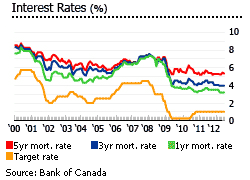
The dear that Canadian housing might be in bubble has been a major concern for the government. In order to ensure a soft landing, tighter mortgage rules take effect on July 9, 2012:
- The reduction of maximum amortization from 30 years to 25 years, discouraging buyers from acquiring too much debt; and
- Maximum LTV ratio was lowered from 85% to 80%.
As the Canadian Mortgage Trends (CMT) reports, the government will also:
- Limit the maximum gross debt service (GDS) to 39%, and the total debt service (TDS) to 44%; and
- Ban mortgage insurance on properties over $1 million.
These measures were applauded by Bank of Canada (BoC) Governor Mark Carney as appropriate and timely, a contribution to reducing household indebtedness. The new mortgage rules are expected to tighten mortgage lending, which the country’s low interest rates won’t.
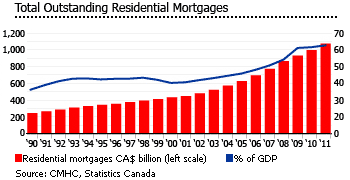
The Bank of Canada has maintained its key interest rate at 1% for 14 policy announcements, since implementation in September 2010.
Actual mortgage rates also remain at historic lows, compared to pre-crisis levels of 2008:
- The 1-year mortgage rate has fallen to 3.2% in May 2012, from 6.15% in May 2008.
- Interest rates on 3-year mortgages have decreased to 3.95% in May 2012, from 6.15% in the previous four years.
- The 5-year mortgage rate has fallen to 5.34% in May 2012, from 6.65% four years earlier.
Higher existing home sales in 2012
Sales of existing homes in Canada are expected to increase by 3.4% in 2012, to 472,300 units, according to the Canadian Mortgage and Housing Corporation (CMHC).
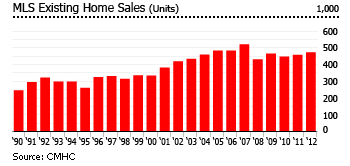
In 2011, rhere was a 2.4% increase in total MLS existing home sales. Leading the increase were Saskatchewan (10.3%) and Alberta (8.1%). Sales of existing homes in Canada peaked in 2007, when 520,511 housing units were sold.
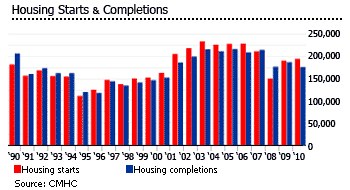
Housing starts slightly increased in 2011, by 2.1% to 193,950 units, having peaked in 2007 at 228,343 housing units. Meanwhile, completions fell by 6.01% in 2011, to 175,623 units. The average number of housing units completed from 2002 to 2008 was 207,244 units per year.
New house prices up a little
Canada’s new housing price index (NHPI) rose by 2.5% during the year to April 2012, according to Statistics Canada. The metropolitan areas with the highest y-o-y price increases were Toronto and Oshawa (5.9%), Regina (5.6%) and Winnipeg (4.3%).
Stable rental market; lower vacancy rate
Average rents in Canada increased 2.1% during the year to April 2012, according to CMHC. Rents for new and existing two-bedroom apartments rose in all provinces, with rises from 0.9% (Quebec) to as high as 6.6% (Manitoba).
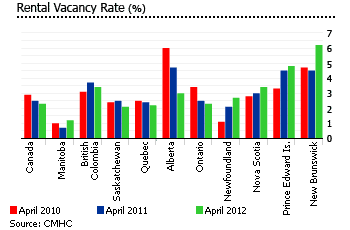
The most expensive rental properties can be found in Alberta, which has average monthly rents of CA$1,055 (US$1,028) for a two-bedroom apartment, followed by British Columbia with CA$1,036 (US$1,010) per month, and Ontario with CA$1,014 (US$988) per month.
Quebec offers the lowest rents for two-bedroom apartments at CA$677 (US$660).
Rental yields in Montreal are really attractive, ranging from 6.30% to 8.19% on small apartments, according to Global Property Guide research of January 2012. The average rental yield in Montreal increased to 7.19%, from its 6.06% average in 2011.
Toronto’s rental yields are lower, ranging from 3.68% to 5.59%. Its average rental yield fell to 4.70%, from an average of 5.71% in 2011.
Due to the country’s improving job market, and the influx of new migrants to major centres, demand for rental apartments has been increasing, causing a decline in the national vacancy rate to 2.3% in April 2012, down from 2.5% from a year earlier, according to CMHC.
Among the provinces, New Brunswick had the highest vacancy rate at 6.2%, followed by Prince Edward Island (4.8%), and Nova Scotia and British Columbia (3.4%). Manitoba had the lowest vacancy rate at 1.2%.
Economic slowdown

In the third quarter of 2013, the economy registered more-than-expected annualized real GDP growth rate of 2.7%, up from 1.6% in Q2 2013 and 2.5% in Q1 2013, and the fastest pace in eight quarters, according to Statistics Canada.
However, the country’s economic growth is expected to slow to 1.6% in 2013 before growing by 2.3% in 2014 and 2.6% in 2015, according to the Bank of Canada (BoC). The Canadian economy expanded by 1.7% in 2012, a slowdown from GDP growth rates of 2.5% in 2011, and 3.4% in 2012, according the BoC.
The nationwide unemployment rate held steady at 6.9% in November 2013 from the past three months but actually unemployment fell from 7.2% in a year earlier, according to Statistics Canada. The Canadian economy created an additional 21,600 jobs in November 2013, though most of the new workers were part-time.
From 2009 to 2012, the average unemployment rate rose to 7.8%, up from an average annual rate of 6.9% from 2000 to 2008, according to the International Monetary Fund (IMF).
In November 2013, the country’s overall inflation rate slowed to 0.7%, below the 1% to 3% target band. In 2012, the nationwide inflation rate stood at 1.5%, from 2.9% in 2011, 1.8% in 2010, 0.3% in 2009, and 2.4% in 2008, according to the IMF.
The BoC kept its key interest rate steady at 1% in October 2013, in place since September 2010.
“We think that interest rates will stay where they are for quite some time,” said Bank of Canada Governor Stephen Poloz. “So issuing a warning that they are almost ready to go up—it’s not the right timing.”